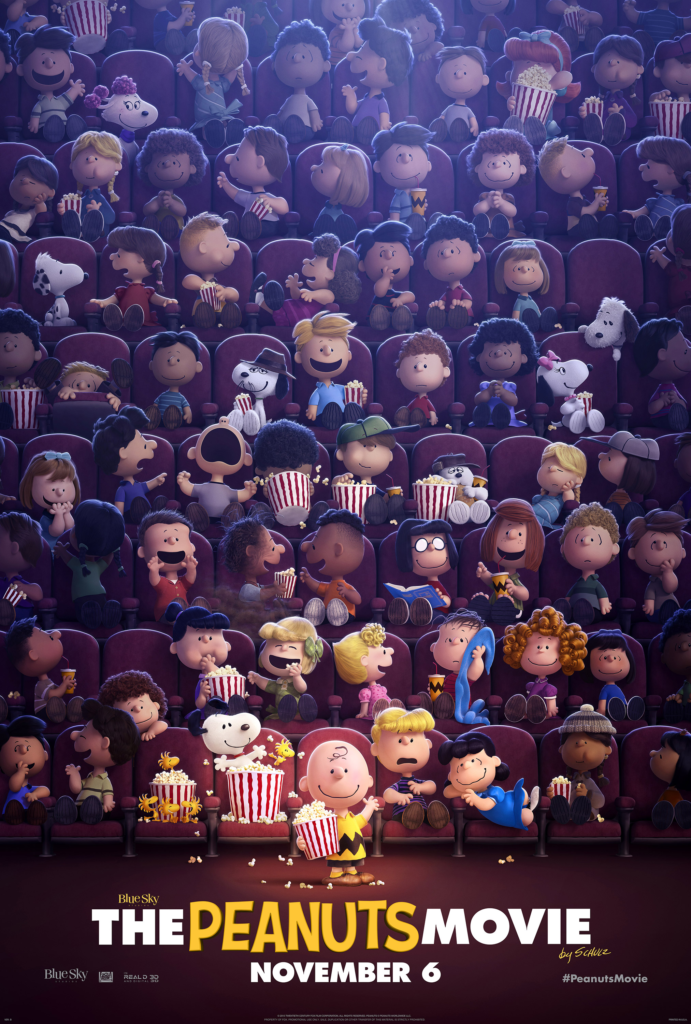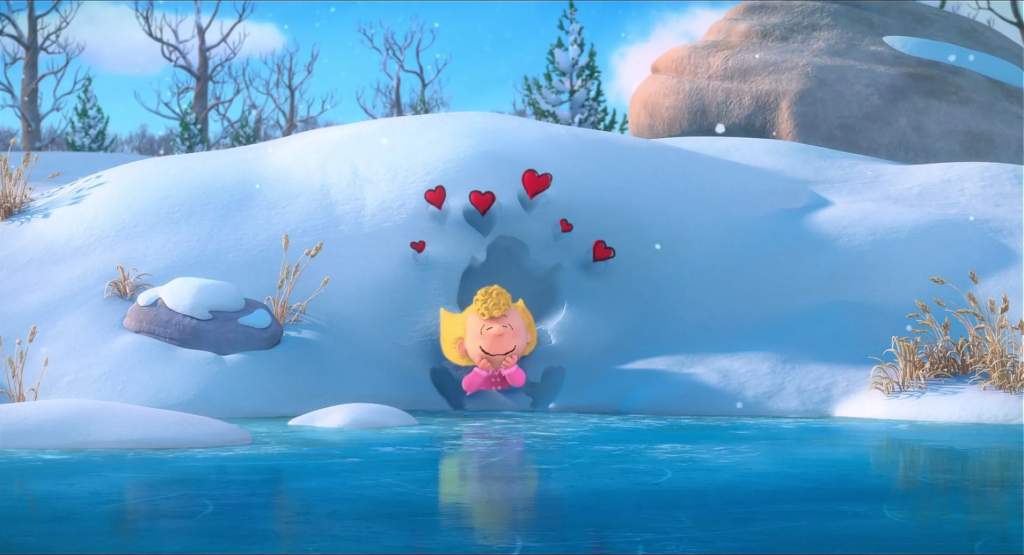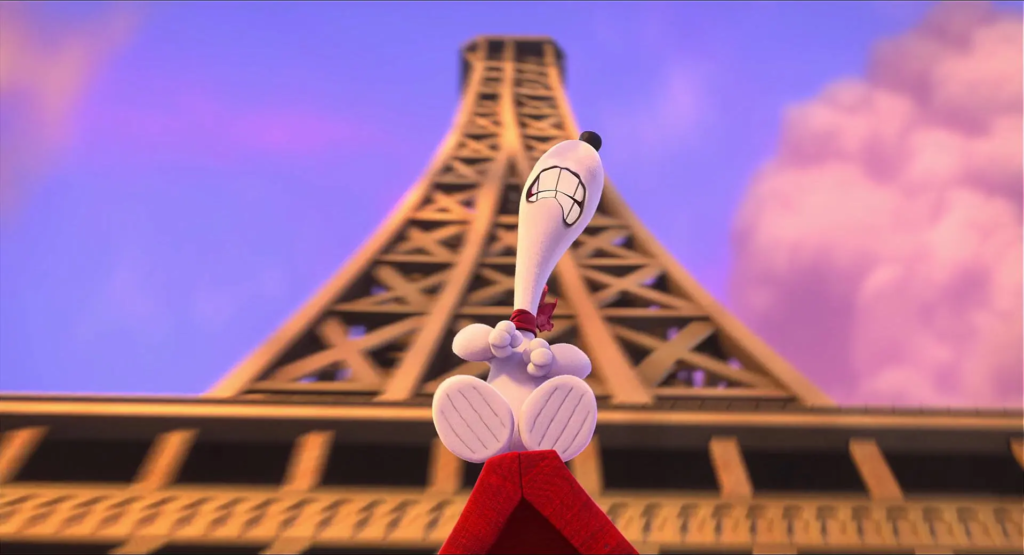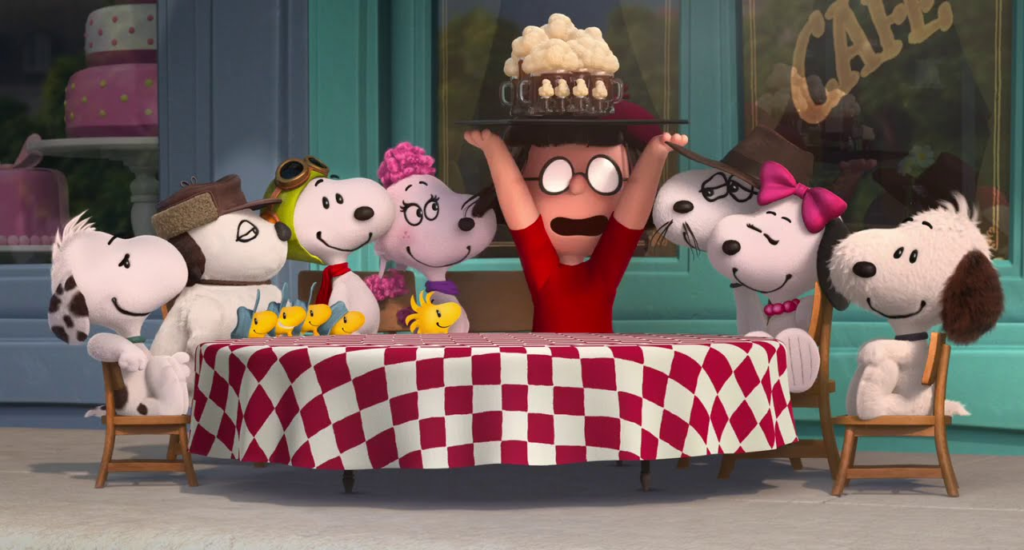Show the World What You Can Do: The Peanuts Movie (2015)

When the news that Blue Sky Studios would be making a computer animated movie based on the Peanuts characters was announced, it was met with some skepticism. Blue Sky’s output (Ice Age, Rio, etc.) was notable for its broad cartoony animation and humor. The visual style of Peanuts was simple, though hard to replicate as any fan who tried to draw the characters can attest, and while certainly not realistic, hardly lent itself to broad cartoony reaction shots or slapstick. Even aside from that, would the flat simple look of Peanuts translate well to three-dimensional animation at all? Wouldn’t the effect be rather grotesque?
On a visual level, Blue Sky Studios and director Steve Martino gave us a happy surprise with The Peanuts Movie. Every character design and pose in it could have come from the comic strip yet everything is subtly more rounded apart from everyone’s eyes and eyebrows which look like the same old dots and squiggles we know and love. Hair, skin, clothes and other surfaces all have texture yet not quite as much as in your average computer animated movie of this vintage. It’s a perfect compromise: enjoyably different from traditional Peanuts visuals yet pleasingly faithful to it as well.


The movie is also blessed with the best voice cast of any Peanuts film since A Boy Named Charlie Brown. As in the Bill Melendez-Lee Mendelson produced Peanuts specials, all the kids are voiced by no-name child actors, and they have the same pleasingly anonymous, innocent sound while also being more polished in their delivery with fewer flat line readings. Special credit goes to Noah Schnapp as Charlie Brown who has to carry the movie on his vocal cords, as it focuses more firmly on his character than any Peanuts film since the first one and who succeeds beautifully. Small wonder he went on to do Stranger Things.
It’s just a shame that the script by Cornelius Uliano, Craig and Bryan Schulz, the son and grandson of Charles, doesn’t give the voice actors funnier things to say. As far as the characters’ personalities go, Charlie Brown, Linus (voiced by Alex Garfin), Lucy (Hadley Belle Miller), Schroeder (Noah Johnston), Sally (Mariel Sheets), Peppermint Patty (Venus Omega Schultheis) and Marcie (Rebecca Bloom) are very true to their counterparts in the funny papers.[1]Though Snoopy is portrayed as a much more loyal friend to Charlie Brown than the selfish beagle of the comic strip and previous Peanuts animation, one who spends most of the movie assisting him in … Continue reading But didn’t anyone involved with the script remember that Peanuts was known for its elaborate verbal humor? A Boy Named Charlie Brown began with someone asking Linus what shapes he could see in the clouds. He replied that he could make out “the profile of Thomas Eakins, the famous painter and sculptor” and “the stoning of Stephen.” It’s around the seven-minute mark when The Peanuts Movie gets to its first verbal joke and it’s nothing as inspired as that. In fact, the film plays better if you interpret it as a drama about a perpetually unsuccessful grade school student than a comedy.

The movie’s biggest laughs come from its slapstick and other visual gags. The character who lends himself the best to Blue Sky’s style is the mischievous, mercurial Snoopy (whose sounds are derived from archival audio of Bill Melendez as the character.) He’s easily the most entertaining thing here. The Peanuts Movie‘s most inspired idea was to combine his two most famous imaginary personas, the world-famous author, typing atop his doghouse, and the World War I flying ace, pretending to fly on his Sopwith Camel AKA that same doghouse. Interspersed with Charlie Brown’s plotline are scenes from the novel Snoop is writing about the flying ace and each story acts as a commentary on the other. Just as Charlie Brown seeks to impress his beloved Little Red-Haired Girl (Francesca Capaldi), the flying ace seeks to impress a beautiful female pilot named Fifi (Kristin Chenoweth who played Sally in a production of You’re a Good Man, Charlie Brown.) And just as Charlie Brown has to struggle against his incompetence and bad luck to do this, the ace has to rescue Fifi from his notorious nemesis, the Red Baron. The fictional hero’s fortunes rise and fall with the confidence of his creator’s master. These fantasy sequences are arguably too elaborate for Peanuts and would fit better in a Calvin and Hobbes movie, but they’re pretty great in their own right.[2]I’d argue there’s something of a precedent for them in the animated specials, most famously It’s the Great Pumpkin, Charlie Brown. The final showdown between Snoopy and the Red Baron is particularly inspired.


To really discuss how this movie adapts Peanuts, I’m going to have to describe the broad outlines of not only its plot but those of A Boy Named Charlie Brown and Race For Your Life, Charlie Brown, so if you don’t want any of those spoiled for you, please skip down to the last few paragraphs of this post.
The Peanuts Movie‘s biggest departure from the general spirit of Charles Schulz is how it sands off the edges of Charlie Brown’s comedically tragic existence. Not that he doesn’t fail often in it. Nor is the idea of him developing real skills or even having an occasional victory completely heretical.[3]Check out this link to read about some surprising wins for his baseball team. In A Boy Named Charlie Brown, desperate to change his fate, he buckled down and really honed a talent that looked like it was going to make him a celebrity, only to trip at the metaphorical finishline. The Peanuts Movie repeats that formula, more or less, four times! Sheer repetition makes the losses frustrating, but it also gives the impression that Charlie Brown is more competent than the comic or the other Peanuts movies and specials do. Reinforcing that impression is the fact that two of those four near victories are lost partly because of his clumsiness but also due to plain bad luck, which, to be fair, has always been a factor in Charlie Brown’s failures. In the other two instances, however, he sacrifices his wins by taking the moral high ground,[4]One of these plot points I distinctly remember seeing on an episode of The Brady Bunch. something not impossible for the pathetic, wishy-washy character of the comic strip but not likely. And then there’s the feel-good ending which fulfills Charlie Brown’s fondest wishes.
What’s wrong with that, you may ask. Don’t you want that? Well…yes, in a way. There’s always going to be a part of me that wishes A Boy Named Charlie Brown ended with him winning the national spelling bee. But another part of me would find that anticlimactic and unsatisfying in the way that getting what you want sometimes feels.[5]It would also be a questionable victory to end with Charlie Brown being beloved by his peers solely because he won. As it is, the ending of A Boy Named Charlie Brown lets Linus’s loyalty shine. … Continue reading There are plenty of sympathetic fictional underdogs whose stories end with them triumphing. Those can be cathartic for real-life underdogs who aren’t ever going to triumph themselves and I never wish for them to go away. But there’s also something cathartic for those real-life underdogs about a fictional underdog who will always be like them or worse off and that’s rarer for mainstream American entertainment. Ultimately, the brutality of the Peanuts universe is just as much part of its appeal as the kindliness of the Phineas and Ferb universe is for it.[6]It’s also worth noting that the cruelty of Peanuts doesn’t seem to have influenced its fanbase to be more meanspirited. When Charlie Brown received no trick-or-treat candy in It’s … Continue reading Race For Your Life, Charlie Brown found a good compromise if you ask me. Charlie Brown doesn’t win the race the way convention and our hearts would dictate but he displays a non-wishy-washiness that earns him the respect of his peers and of himself. The same thing basically happens at the end of The Peanuts Movie but it’s a lot more indulgent and on the nose with the moral than I’d prefer. Still, I’d be lying if I claimed the climactic line, “it must feel pretty great being Charlie Brown right about now,” didn’t make me grin.

The upshot of all this is that this Peanuts Movie is less an example of Peanuts magic than a fond tribute or homage to it. It’s frustrating because it didn’t have to settle for being that. Recently, Kaboom comics has produced some marvelous original Peanuts comic books, ones which are humorous in a Schulzian way while also doing their own thing.[7]Though the quality of these comic books has been sadly on the decline. Their take on Race For Your Life was far too sanitized for my taste. It’s too bad Vicki Scott or Jeff Dyer couldn’t have written this movie. Still, as far as tributes go, the 2015 Peanuts Movie is an enjoyably elaborate, lovingly made one. It’s packed with fun references to the comic strip and the old, animated specials. It even manages to work Schulz’s favorite novel, War and Peace, into the plot.[8]Too bad they couldn’t do the same with Citizen Kane. Even the sentimentalizing of the main character feels like the work of a fan wanting to see their favorite character be a hero. The very end credits are full of Easter eggs for Peanuts lovers. For many children, this movie was probably their introduction to the characters. I don’t think it works very well on that level. It may give me joy to hear Linus say he hopes his new neighbor will have an open mind about the Great Pumpkin, but I don’t know what the uninitiated make of it. A Boy Named Charlie Brown is what I would recommend as an introduction to Peanuts for newcomers. The Peanuts Movie I would recommend for nostalgic fans of the franchise who can keep their expectations reasonable.

Conclusion
So, which of these four movies do I consider the best? That’s hard to say. A Boy Named Charlie Brown encapsulates what Peanuts is all about to me the most but Race For Your Life, Charlie Brown is the one I have the most fun watching. That’s a wishy-washy conclusion but that feels right for a series analyzing movies about good ol’ Charlie Brown.

References
| ↑1 | Though Snoopy is portrayed as a much more loyal friend to Charlie Brown than the selfish beagle of the comic strip and previous Peanuts animation, one who spends most of the movie assisting him in his quest for self-worth. For what it’s worth, this benefits the movie in that it allows it to include plenty of Snoopy without contrivance. Patty (Anastasia Bredikhina)’s crush on Pig-Pen (A. J. Tecce) is also original to this movie though there was a time in the comic strip’s long history when Pig-Pen and Peppermint Patty were romantically linked. Could the screenwriters have confused Patties? Anyway, I don’t mind since the idea of anyone being besotted by Pig-Pen is hilarious. |
|---|---|
| ↑2 | I’d argue there’s something of a precedent for them in the animated specials, most famously It’s the Great Pumpkin, Charlie Brown. |
| ↑3 | Check out this link to read about some surprising wins for his baseball team. |
| ↑4 | One of these plot points I distinctly remember seeing on an episode of The Brady Bunch. |
| ↑5 | It would also be a questionable victory to end with Charlie Brown being beloved by his peers solely because he won. As it is, the ending of A Boy Named Charlie Brown lets Linus’s loyalty shine. Only he is friends with Charlie Brown throughout the whole thing, both when his star is rising and when it falls. |
| ↑6 | It’s also worth noting that the cruelty of Peanuts doesn’t seem to have influenced its fanbase to be more meanspirited. When Charlie Brown received no trick-or-treat candy in It’s the Great Pumpkin, Charlie Brown and no valentines in Be My Valentine, Charlie Brown, the original kid viewers sent him their own and a look at the comments section for Peanuts on GoComics.com shows that the average fan hates the bullying Lucy. |
| ↑7 | Though the quality of these comic books has been sadly on the decline. Their take on Race For Your Life was far too sanitized for my taste. |
| ↑8 | Too bad they couldn’t do the same with Citizen Kane. |
